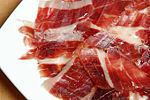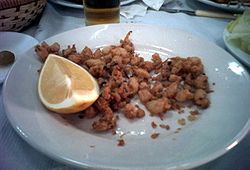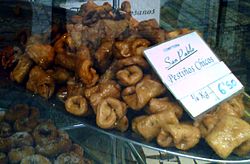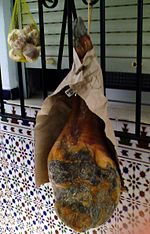- Andalusian cuisine
-
Andalusian cuisine is rather varied, corresponding to a region that is itself extensive and varied. Notwithstanding that, the cuisine of Andalusia is characterized by gazpacho, fried fish (often called pescaito frito in the local vernacular), the jamones of Jabugo, Valle de los Pedroches and Trevélez, and the wines of Jerez, particularly sherry.
Contents
Fried foods
Frying in Andalusian cuisine is dominated by the use of olive oil that is produced in the provinces of Jaén, Córdoba, Seville, and Granada. The foods are dredged in flour a la andaluza (meaning only flour, without egg or other ingredients, but may include flour from the chickpea especially for use in batters). They are then fried in a large quantity of hot olive oil.
Fish and shellfish
With five coastal provinces, the consumption of fish and shellfish is rather high: white shrimp from the Bay of Cádiz; prawns; murex; anchovies; baby squid; cuttlefish; "bocas de la Isla", a dish found in San Fernando that uses a local crab that can regenerate its claw; flounder; smelts; etc.
Andalusian cuisine includes also some unusual seafood, like ortiguillas, sea anemones in batter.
Desserts
Andalusian desserts are heavily influenced by medieval Andalusian cuisine. Notable dishes include pestiños (a deep-fried pastry bathed in honey), alfajores, amarguillos (a form of almond macaroons) from Medina Sidonia, the polvorones (almond cookies of Estepa), lard bread, wine doughnuts, and torrijas.
Wines and liquors
The wines of Jerez (also known as sherry) are famous the world over, praised even by William Shakespeare. Other standouts are the manzanilla of Sanlúcar de Barrameda, the white wines of Cádiz, paxarete (a sherry derivative), wines of Condado in Huelva, wines of Montilla-Moriles in Córdoba, wines of Málaga, and la tintilla of Rota. The liquors of the region are also popular, included the anís made in Rute, and in Cazalla de la Sierra, and the rums from the Tropical Coast of Granada (Motril).
Typical dishes
Typical Andalusian dishes include pescaito frito (fried fish), gazpacho, Cordoban salmorejo, pringá, oxtail, jamón ibérico (Iberian ham), prepared olives, alboronía, poleá, anise, and various kinds of wine, including sherries (fino, manzanilla, oloroso, Pedro Ximénez, amontillado) which are undoubtedly the most exported and most widely available of all Spanish wines, as well as Málaga wine. The wine from Montilla, while similar to sherry, is not technically a sherry, but gives its name to amontillado, meaning "in the style of Montilla".
Some other Andalusian dishes include:
- Salmorejo (Córdoba)
- Flamenquín (Córdoba)
- Ajoblanco (Málaga-Cádiz)
- Gazpacho andaluz
- Pipirrana (Jaén)
- Habas con calzones
- Huevos a la flamenca
- Alcauciles rellenos (Cádiz)
- Migas de Harina
- Gachas
- Tortillas de camarón (Cádiz)
- Puchero
- Gazpachuelo (Málaga)
- Biénmesabe o adobo
- Ajo harina (Jaén)
- Soldaditos de Pavía
- Pringá
- Patatas a lo pobre
- Tortilla de patatas
See also
References
- This article draws heavily on the 19 January 2006 version of the corresponding article in the Spanish-language Wikipedia.
External links
- Gastronomía Andaluza en Tertulia Andaluza
- Grupo Gastronómico Gaditano
- Official Web site for sherry
- Take a Taste of Andalusia
- Andalusian recipes(Spanish)
History Language Sports Cuisine Ajoblanco · Andalusian Breakfast · Andrajos · Calentitos · Gazpacho · Jamones · Gachas Andaluzas · Migas · Pescado frito · Polvorón · Pringá · Salmorejo · Sangria · Sherry · Tapas · Various dishes Seafood-based · WinesMusical instruments Typical music Flamenco · Sevillanas · Bulerías · Pasodoble · Verdiales · New Flamenco · Flamenco Chill · Cante chico · Cante jondo · Cantiñas · PaloTraditions and feasts Carnival of Cádiz · Cavalcade of Magi · Holy Week · Horse Fair · Powder Day · Seville Fair · Velá de Santa Ana · Toro de fuegoMusic festivals CategoryCategories:
Wikimedia Foundation. 2010.





